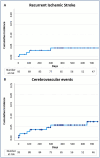Percutaneous Left Atrial Appendage Closure in Patients With Cardioembolic Breakthrough Stroke: An International Observational Study
- PMID: 40985135
- PMCID: PMC12455140
- DOI: 10.1111/ene.70365
Percutaneous Left Atrial Appendage Closure in Patients With Cardioembolic Breakthrough Stroke: An International Observational Study
Abstract
Background: Patients with non-valvular atrial fibrillation (AF) who experience an ischemic stroke despite oral anticoagulation (OAC) are at particularly high risk of recurrence, with a reported annualized ischemic stroke rate of 5.3%-8.9%. The optimal strategy for secondary prevention in these patients remains unknown.
Methods: We reviewed all percutaneous left atrial appendage closures (LAAC) attempted in AF patients experiencing an ischemic stroke under OAC and who were prospectively collected in four European centers. All index strokes were categorized by an experienced neurologist to exclude patients with non-cardioembolic etiology or insufficient OAC. The primary endpoint was a recurrent ischemic stroke at 2 years after the procedure. Secondary endpoints included procedure-related complications and 2-year death.
Results: Of 2234 patients submitted to LAAC procedure, 95 had a cardioembolic breakthrough stroke. LAAC procedures were performed at a mean of 4 months after the breakthrough stroke. The main antithrombotic therapy at discharge (83%) and at the latest follow-up (79%) consisted of OAC. At the median follow-up of 713 days, the primary endpoint occurred in 4 patients (4%). Procedure-related complications were rare (1%) whereas death occurred in 5% of patients.
Conclusion: LAAC procedures were safe and feasible in patients with cardioembolic breakthrough stroke. Recurrent stroke rates were lower than those reported in previous studies with OAC continuation after breakthrough stroke, suggesting a potential additive protection by LAAC on top of OAC. Results from ongoing randomized trials are required to validate our findings.
Keywords: atrial fibrillation; breakthrough stroke; left atrial appendage closure; oral anticoagulation; stroke.
© 2025 The Author(s). European Journal of Neurology published by John Wiley & Sons Ltd on behalf of European Academy of Neurology.
Conflict of interest statement
R.G. is a proctor and consultant for Abbott and reports speaking honorarium from Boston Scientific and research grants from Swiss Heart Foundation. E.A. reports research funding from the Gottfried & Julia Bangerter Rhyner foundation. U.F. reports research grants from the Swiss National Science Foundation, the Swiss Heart Foundation, from Medtronic (BEYOND SWIFT, SWIFT DIRECT) and from Stryker, Rapid medical, Penumbra, Medtronic and Phenox (DISTAL), Boehringer Ingelheim (TECNO). Support of the Horton Foundation for the DO IT trial. Consultancies for Medtronic (fees paid to institution). Participation in an advisory board for AstraZeneca (former Alexion/Portola), Bayer, Boehringer Ingelheim, Biogen, AbbVie, Siemens (fees paid to institution). Member of a clinical event committee (CEC) of the COATING study (Phenox). Member of the data and safety monitoring committee (DSMB) of the TITAN, LATE_MT, IN EXTREMIS and RapidPulse trials. L.R. reports research grants to institution by Abbott‐Vascular, Boston‐Scientific, Biotronik, Heartflow, Sanofi, Regeneron. He reports speaker/consultation fees by Abbott‐Vascular, Amgen, AstraZeneca, CSL‐Behring, Canon, Occlutech, Sanofi, Vifor. All other authors have reported that they have no relationships relevant to the contents of this paper to disclose.
Figures
References
-
- Wolf P. A., Abbott R. D., and Kannel W. B., “Atrial Fibrillation as an Independent Risk Factor for Stroke: The Framingham Study,” Stroke 22, no. 8 (1991): 983–988. - PubMed
-
- Ruff C. T., Giugliano R. P., Braunwald E., et al., “Comparison of the Efficacy and Safety of New Oral Anticoagulants With Warfarin in Patients With Atrial Fibrillation: A Meta‐Analysis of Randomised Trials,” Lancet 383, no. 9921 (2014): 955–962. - PubMed
-
- Stretz C., Wu T. Y., Wilson D., et al., “Ischaemic Stroke in Anticoagulated Patients With Atrial Fibrillation,” Journal of Neurology, Neurosurgery, and Psychiatry 92, no. 11 (2021): 1164–1172. - PubMed
Publication types
MeSH terms
Substances
LinkOut - more resources
Full Text Sources
Medical


